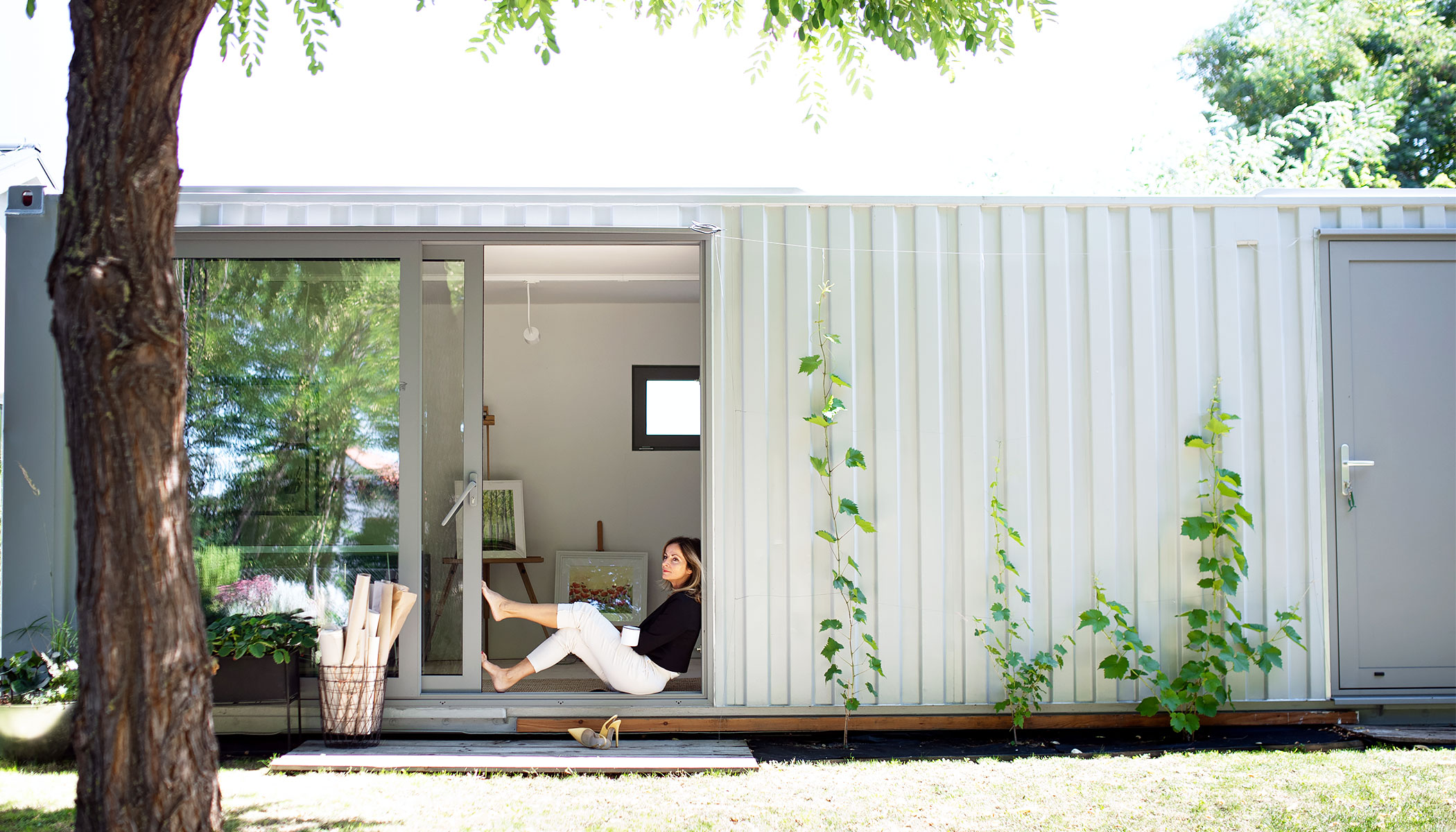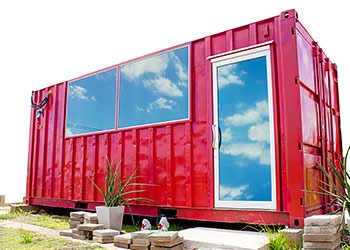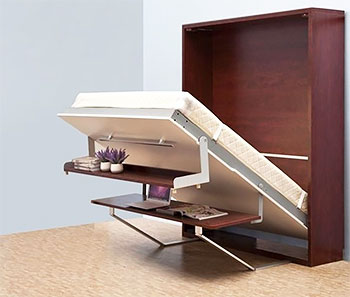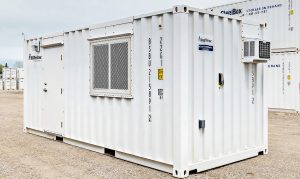
Shipping Container Homes: Pros and Cons - BigSteelBox
Pros And Cons of Shipping Container Homes
Post updated on Sept 5, 2023
A shipping container is a large box made of steel that is traditionally used for storage and to transport goods long distances. Shipping containers are constructed from Corten steel (or weathering steel) and come in a few different sizes, but the most common sizes of a standard shipping container are 8’x20’ or 8’x40’. They are built to withstand inclement weather and abuse during transport by ocean, rail or land, and usually have a shipping lifespan of 25 years.
A shipping container home is exactly what it sounds like: a living space constructed from a standard shipping container or containers, sometimes involving the welding together of more than one container to make a structure wider or taller, that is modified to have most of the things you’d find in a traditional house.
It’s likely you’ve heard a lot about people who are choosing to abandon traditional, larger, wood frame homes for “tiny homes” that are more affordable to build and maintain, more environmentally conscious and, ultimately, offer a simpler, more minimalist way of living. Right along with the tiny home movement comes container homes, which continue to gain popularity for many of the same reasons.
While BigSteelBox offers shipping container modifications such as adding electrical options like heat, lights and cooling, as well as insulation, windows and doors, we do not build or sell container homes. However, we do sell new and used containers to those planning to outsource the work or complete the construction themselves.
If you’re considering a build like this, but still on the fence about it, read on for some pros and cons of shipping container homes.
Pros of Shipping Container Homes
1. Durability and Strength
As mentioned above, shipping containers are made of tough, corrugated Corten steel, which can withstand extreme weather conditions and constant movement. Thanks to its strong steel frame, walls, ceiling and floor, it won’t bend or shift under the weight of its contents. Fun Fact: Some bridges are made from Corten steel!
Shipping containers are made to protect belongings from the elements when being shipped by sea, rail and land. As such, building a home inside of a shipping container (or containers) would provide the same structural and security benefits.
2. Fast Construction
 Shipping container homes can be completed much more quickly than the average new build home construction with a wood or concrete frame. This is true for a few reasons, but mainly it’s because container houses are built on a smaller scale than most other homes. Plus, the container structure itself (the frame) has already been manufactured and only needs modifications to make it livable.
Shipping container homes can be completed much more quickly than the average new build home construction with a wood or concrete frame. This is true for a few reasons, but mainly it’s because container houses are built on a smaller scale than most other homes. Plus, the container structure itself (the frame) has already been manufactured and only needs modifications to make it livable.
3. Mobility
Another pro to shipping container housing is that they’re portable! And because of their steel frame, you don’t have to worry about it bending or shifting in transport.
Depending on their size, container homes can be moved and transported by either a forklift for individual containers under 10,000lbs, or crane for larger container structures. Assuming the container house has electricity, water and septic, there will need to be proper disconnection and reconnection to those sources before and after moving it, but the structure itself is usually mobile and you could even move it to a different city if you wanted to.
4. Lower Cost to Build
According to Altus Group’s 2022 Canadian Cost Guide, building a traditional single-family home in Canada ranges from $100 to $275 per square foot, depending on where you live.
“Just like buying a house, Vancouver and Toronto are the most expensive cities in which to build a new home in Canada. In Vancouver, the process costs between $150 and $275 per square foot, while in the Greater Toronto Area it runs from $165 to $260 per square foot. Calgary and Edmonton, where prices range from $125 to $200 per square foot, are cheaper options.” Zoe Demarco, dailyhive.com
In addition to location, costs will also differ based on the types of material and finishes you choose to use, but on average, the cost to build a new 2,500 sq ft wood frame home in Canada, excluding the cost of the land/lot and other requirements (i.e. electrical and plumbing connections in a city or rural area), can range between $250,000 – $680,000.
Building a shipping container home is cheaper based on a few factors. Obviously, they’re built on a much smaller scale and you’ll need less materials to complete the interior, so the materials and labour involved will cost less.
The structure or frame of a container home is already there, so you’re actually modifying it versus building from scratch. As such, the main factor to consider when pricing out the “shell” of your container home is the number of containers you need to purchase for the home, and modification costs if more than one container will need to be cut and welded together.
How much does it cost to buy a new shipping container?
To give you an idea of what it costs to buy a new 20′ shipping container in Canada, below is some pricing for reference. It’s important to note that pricing varies from city to city, and will also be impacted by availability, size and condition*:
- Lower Mainland, BC: $3,995
- Kelowna, BC: $4,095
- Calgary, AB: $3,995
- Regina, SK: $4,745
- Winnipeg, MB: $4,895
- Ottawa, ON: $4,195
- Mississauga, ON: $3,145
*Prices above are excluding taxes, subject to change without notice, and do not include delivery.
After the cost of the container(s), the remaining work will also depend on where you live and the finishings and features you want. Smaller, more basic container homes can range between $25,000 to $40,000, while larger homes built with multiple shipping containers and more customized features can range in price from $100,000 to $175,000.
5. Unique Designs
 When constructing a container home, you aren’t limited by traditional building methods or designs. Shipping containers can be used in extremely unique and creative ways! A lot of these homes have a modern, industrial feel once they’re completed, which is popular within the “minimalism” design style.
When constructing a container home, you aren’t limited by traditional building methods or designs. Shipping containers can be used in extremely unique and creative ways! A lot of these homes have a modern, industrial feel once they’re completed, which is popular within the “minimalism” design style.
While you’ll have to find ways to make the most out of a smaller space on the inside of your container home, this is actually another opportunity to get creative. Just be sure to do some research on the latest space saving designs and layouts.
To maximize the use of your space, choosing furniture that can be tucked away or used for more than one purpose is ideal when decorating a tiny or container home. For example, a wall bed (often called a Murphy bed) may be a good choice as there are styles available that allow it to double as shelving or a desk/workspace when it’s stowed away. There is also plenty of furniture and designs that have built-in storage, which that can be handy in a container home while also being stylish.
Wall bed photo courtesy of visualhunt.com.
Cons of Building a Shipping Container Home
 On the other side of the coin, there are also challenges and downsides to building a shipping container home. Here are a few of the cons you’ll want to consider.
On the other side of the coin, there are also challenges and downsides to building a shipping container home. Here are a few of the cons you’ll want to consider.
1. Limited Supply
The COVID-19 pandemic caused many challenges for manufacturing and shipping sectors all over the world. Many factories were shut down and stopped production for long periods of time, which affected the supply of all sorts of goods. In addition, many shipping lines were closed or slowed significantly. Both of these factors directly affected the ability to produce new shipping containers in China and move them to other countries, like Canada.
As such, shipping containers have been in low supply and high demand since late 2020, and while the industry is slowly recovering, it continues to affect their availability and pricing. Because most container companies in Canada focus on renting containers for moving and storage purposes or transporting goods, fewer have been available for purchase.
When building a container home it’s best to use “new” or “one trip” containers so that they will be in better condition and last longer. Due to the supply shortage and the limited ability to bring a new container from overseas, purchasing new shipping containers can be more expensive and take longer than usual.
2. Limited Space
Although a shipping container is a great option for temporary or long term storage, it is a very small space for a person (or people) to live in.
The average 8’x20’ container gives you 160 square feet of space, whereas an 8’x40’ container offers about 320 square feet of living space. There is the option to combine multiple containers to create a bigger space, but doing so will increase costs and time because there will be work needed to retro-fit them into one unit.
So, the main takeaway here is that you’ll need to think things through and be realistic about your ability to live in such a small space.
3. High Temperatures
A shipping container can get extremely warm during the summer months if they aren’t well insulated and equipped with proper venting and cooling systems. Because containers are made from steel, without insulation they will absorb heat and warm the interior quite quickly.
This means you will need to add some type of insulation to your container, as well as a wall finish, vents and ideally a built-in air conditioner. If done properly, this can be done efficiently and look great in the end, but will take a bit of space away from your already limited square footage.
4. Possible Health Hazards
There is the possibility of health hazards associated with living in a shipping container home, but this con is more likely to be an issue when older, second hand containers are used. This is because there’s the possibility that chemicals were used to treat the wooden flooring, or the paint used to protect it from seawater during transport may release toxins.
So, while using new containers may cost more but be safer, some people want to use second hand containers to leave a smaller environment footprint.
“If you are using the new containers to build your home, then you need not worry about these (health) concerns as you can always dictate to your manufacturer, not to treat the floors or to coat the containers with harmful chemicals. However, using new shipping containers to build your home is sure to increase the cost and it also defeats the environment-friendly credits that you would have gained by using recycled shipping containers.” Susan Tora, Customer Success Manager at InnoDez
Using spray foam insulation, non-breathable underlay and flooring, adding vents and exhaust fans to help with airflow will help reduce the health risks, however, it’s still important to research this topic and discuss it with your contractor.
5. Zoning and Permits
Because shipping container homes are a fairly new trend, most cities don’t have specific regulations in place for them. This may result in the zoning and permit process taking longer than usual, or even being denied.
In addition, each province will have its own building codes and requirements that must be met for it to be approved. This can include items like emergency access, alarms, energy efficiency and plumbing. We recommend contacting your local city planning office for more information about building codes, zoning restrictions, and permitting requirements for container homes, or find a contractor with experience in this area.
6. Construction Challenges
The fact of the matter is that shipping containers are not designed or built as living quarters so there are bound to be construction challenges. Unlike wood frame structures where a home is built from the ground up and leaving spaces for doors, windows, plumbing, etc., are part of the process, modifying a shipping container requires openings to be cut from steel walls, and you’ll likely need to get creative when it comes to putting in a bathroom. And, every “extra” you add will take away more precious space that is already scarce.
Also keep in mind that steel can rust if it’s exposed to certain elements and not properly protected. According to containerhomehub.com, rust occurs on shipping containers when they are exposed to moisture and oxygen, which leads to oxidation (the breakdown of iron-based metals). Rust can weaken the structure of a shipping container home and lead to additional problems, such as leaks and water damage.
“When left unchecked, rust can create serious problems for your container home. It can weaken the containers, which increases the risk of structural damage during a storm. Rust may also lead to gaps that allow moisture to reach other areas, causing water damage and leaks inside your home.” Gail Rose, containerhomehub.com
To prevent rust, shipping containers must be coated with a protective layer of paint or an acrylic finish to prevent moisture from reaching the steel underneath. You’ll also want to ensure you especially protect the roof from pooling water, install an effective gutter system, and repair any areas showing signs of rust as soon as possible.
Where to Find Shipping Containers to Convert into Homes
Depending on where you live, there are likely a few companies that sell new and used shipping containers, including BigSteelBox. There are even some that will build your home for you and deliver it to your location.

While BigSteelBox does not build container homes, we can complete a variety of modifications to your purchased container before we deliver it to you. Check out our Modifications section to learn more about those options.
To give you an idea of the container modification process, this is how we build a shipping container office. Obviously a container house would have many more requirements, such as plumbing, storage, and a place to sleep, so it’s important to do your research, enlist the help of professionals when needed, and be prepared before you start to build your dream container home.




